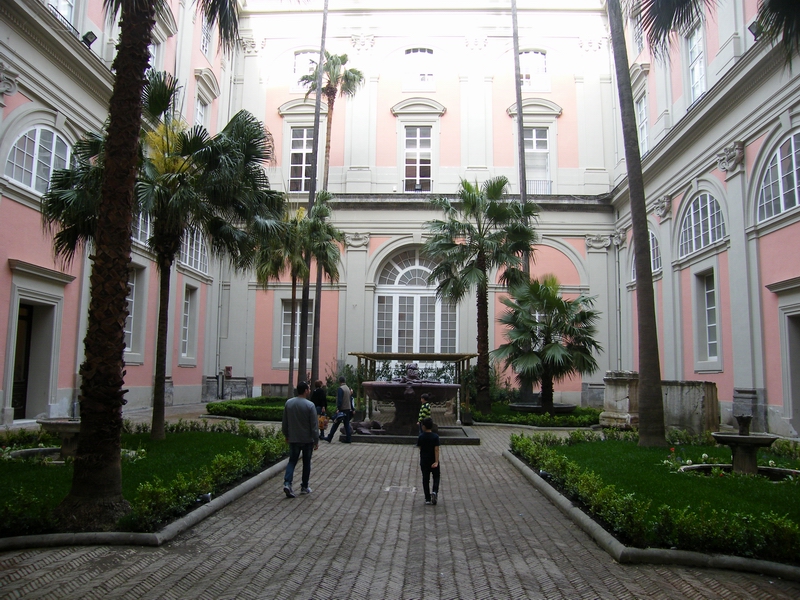Indice dei Musei
presenti in miti3000
Napoli Museo Nazionale
Napoli Museo Nazionale

Il “Giardino delle Fontane” si configura in un parterre con un modulo quadripartito; quattro sono, infatti, gli spazi che lo formano, divisi da vialetti ortogonali collegati a un viale che corre lateralmente lungo le pareti del cortile dell’edificio. Le quattro aiuole presentano gli angoli rivolti verso il centro del cortile conformati a semiarco, così da formare complessivamente uno spazio circolare in cui è presente un rialzo quadrangolare in pietra su cui è posizionata una fontana in porfido rosato, di un raffinatissimo stile artistico, denominata nell’Ottocento “Gran Tazza in porfido Farnesiana” o “Gran Cratere” mentre, al centro di tre aiuole, sono presenti tre piccole fontane. Nel progetto di recupero del cortile tale configurazione geometrica è stata conservata, così come i rialzi in pietra al centro dei parterre e la fontana in porfido rosato. Il Cortile orientale è stato rinominato “Cortile delle Fontane” proprio per le tre fontane incluse negli spazi verdi. Gli interventi di recupero |e valorizzazione si sono fondati sui concetto di restituzione della valenza storica dei giardini, partendo da un lavoro di rimozione delle specie vegetali non consone a questa tipologia di giardino storico. In un’aiuola la siepe di bosso rotundifolia è stata preservata interamente, mentre nelle altre tre aiuole, che presentavano specie vegetati diverse e deteriorate, per recuperare l’uniformità sono state completamente sostituite con la stessa specie. Sono state rimosse, inoltre, tutte le siepi che cingevano le tre fontane. Per quanto riguarda la componente floristica, il cortile presentava alcune specie arbustive ormai deteriorate e piante arboree costitute solamente da diversi tipi di palma, tra cui alcune Washingtonia di notevole pregio e dimensioni. Le specie arbustive sono state rimosse per dare più spazio vitale alle palme, mentre queste ultime sono state oggetto di diversi interventi manutentivi, tra i quali potature di conservazione e di rimonda. il tappeto erboso di tutte le aiuole, ormai in fase di fine periodo vegetativo, presentava numerose specie vegetali infestanti colonizzatrici, uno spesso strato muscinale e un’epatica particolarmente aggressiva.
Queste infestazioni si erano estese anche nelle pavimentazioni dei viali adiacenti, costituite da mattoni in cotto a spina di pesce, rendendoli particolarmente scivolosi e pericolosi per l’incolumità pubblica. Per muovere lo strato muscinale e l’epatica dalla pavimentazione dei viali sono stati utilizzati biocidi idonei a questo scopo che, oltre a eliminare la colonizzazione e la patina biologica dalle superfici, ne impediscono la ricolonizzazione biologica rapida creando sul cotto una superficie “grippante” che impedisce l’effetto sdrucciolo e l’azione corrosiva. Dopo il ripristino e l’automazione dell’impianto d’irrigazione, è stato sostituito completamente il tappeto erboso con rotoli di prato pronto, composto di un miscuglio di specie vegetali rustiche a basso input manutentivo. Sono state, inoltre, messe a dimora specie bulbose a fioritura scalare durante tutto l’anno. Particolare attenzione è stata posta all’illuminazione e all’arredo del giardino attraverso l’inserimento di punti luce tali da creare un’illuminazione calda e soffusa, conservando lo spirito fortemente romantico già rappresentato da epigrafi e basi di colonne.
The “Garden of the Fountains” is laid out as a parterre with a quadripartite module. It comprises four spaces, divided by orthogonal paths which join an avenue that runs along the side walls of the building’s courtyard. The four beds of flowers have their corners facing the center of the courtyard shaped as semi-arches, so forming a circular space with a quadrangular stone raised base on which rises a fountain in pink porphyry, in a refined artistic style, termed in the nineteenth century the “Great Cup in Farnesian porphyry” or the “Great Krater” while, at the center of the three flower beds there are three small fountains. In the design for the recovery of the courtyard. this geometrical pattern has been retained, as well as the stone risers in the middle of the parterre and the pink porphyry fountain.
The eastern courtyard was renamed the “Courtyard of the Fountains” because of the three fountains included in the green spaces. Their restoration and valorization have been based on the concept of recreating the historical qualities of the gardens, starting with the work of removing plant species not suited to this type of historical garden. In a flowerbed the hedges of boxwood (var. rotundifolia) nave been preserved in full, while in the other three beds presenting different and deteriorated plant species, to restore their uniformity the plants were completely replaced with the same species. Also removed were all the hedges that surrounded the three fountains. As regards flowering plants, the courtyard contained some shrub species which had become impaired and arboreal species consisting only of different varieties of Washingtonia palms, including some fine specimens of considerable size. The shrub species have been removed to give more space to the palms while the latter have been subiected to different kinds of maintenance. including pruning for conservation and to clear away dead wood. The turf in all the lawns, now nearing the end of the growing season, contained numerous species of colonizing weeds. a thick layer of moss and a particularly aggressive species of hepatica. These had spread into the paving in the adjacent avenues, consisting of terracotta bricks laid in a herringbone pattern, making them very slippery and dangerous for the public safety. To remove the moss layer and the hepatica from the paving of the avenues, biocides suitable for the purpose were used. In addition to eliminating the colonization and the biological patina from the surfaces, they will prevent its rapid regrowth, while creating a firm surface on the terra cotta paving that will prevent slipping and corrosion. After the restoration work and installation of an automatic watering system, the turf was completely replaced with rolis of grass, consisting of a mixture of hardy low maintenance species. Various species of bulbs that would flower in succession troughout the year were also planted. Particular attention was paid to the lighting and furnishing of the garden through the insertion of spotlights, creating warm, soft lighting and preserving the highly romantic spirit already represented by the epigraphs and column bases.